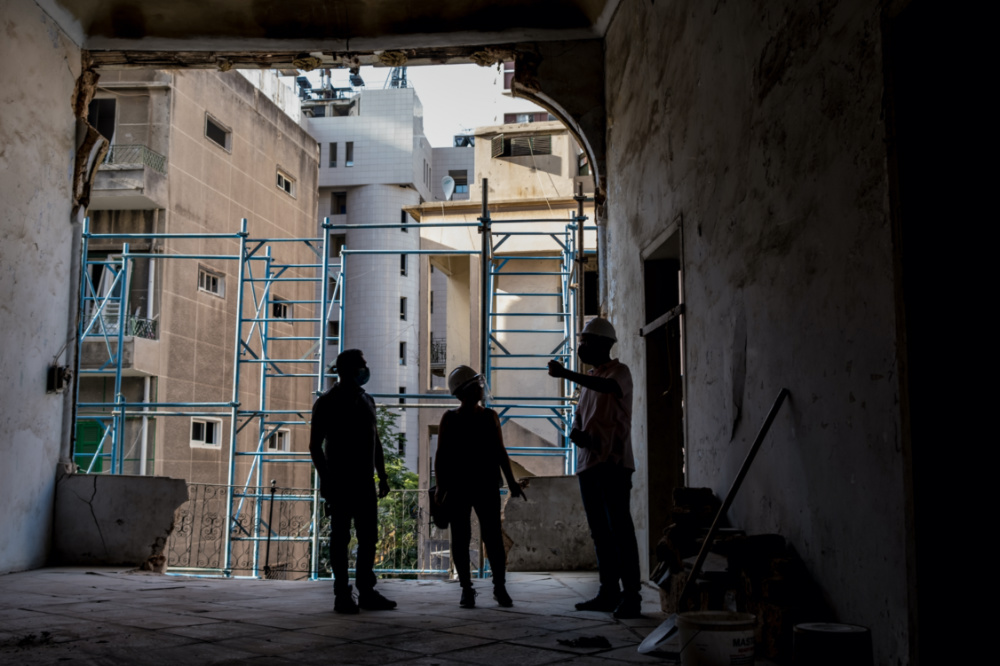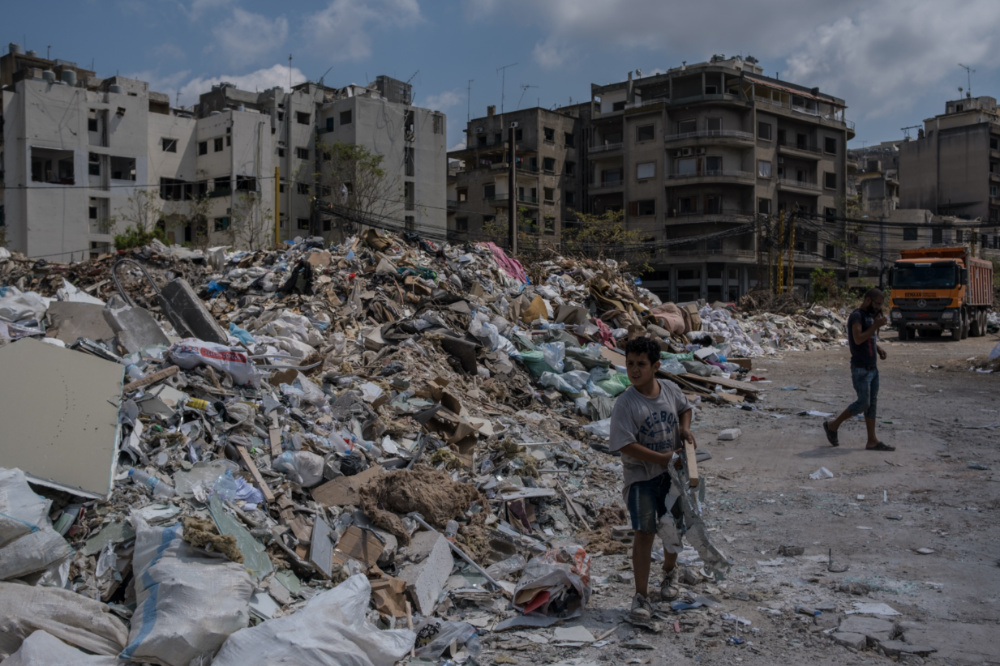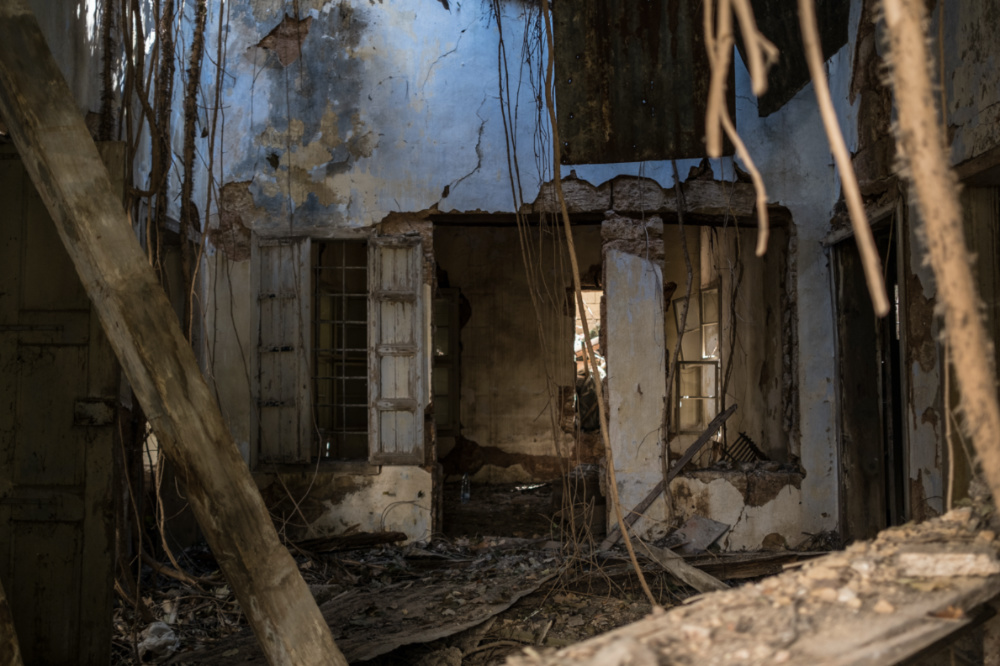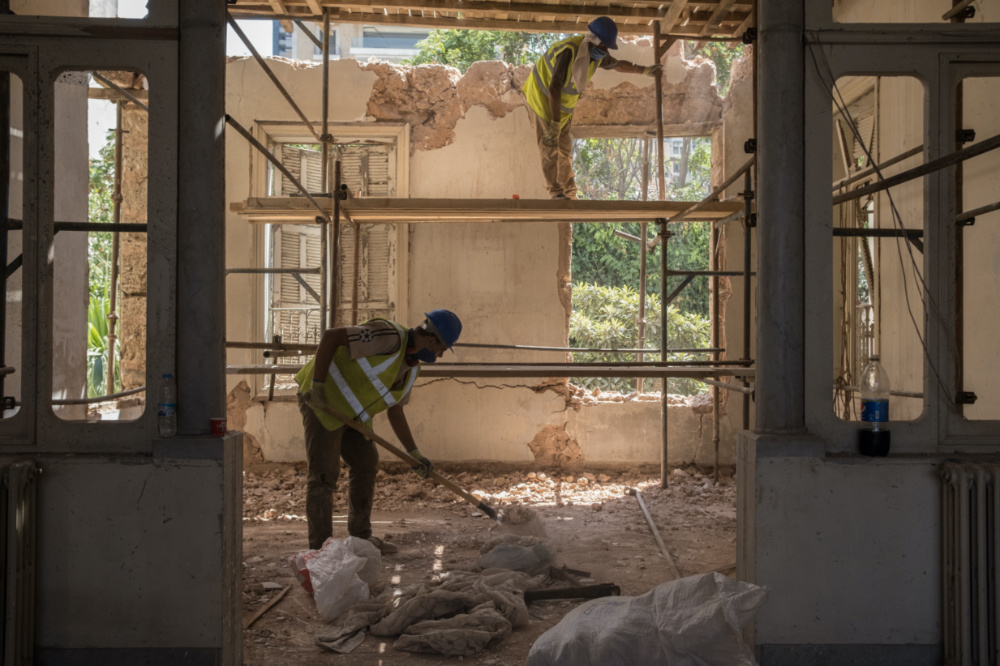
STEPHANIE GLINSKI, of Thomson Reuters Foundation, reports…
Beirut, Lebanon
Thomson Reuters Foundation
Built in 1920, the house that Riad Asad’s family has called home for decades outlasted 15 years of civil war but took what could be a fatal blow in last month’s mammoth, port-side explosion.
Asad says his family – who has sought refuge outside Beirut – wants to restore the elegant home, with its high, ornate ceilings, arched windows and marble floors.
It faces quite a task.

Members of the Beirut Built Heritage Rescue 2020 initiative are standing in a damaged heritage home on 26th August in Beirut, Lebanon. PICTURE: Thomson Reuters Foundation/Stefanie Glinski.
The roof is caved – right to the dusty floor – and its structural bones are in danger of total collapse.
In the sitting room, a grand piano sits shrouded in blankets, lit by the warm afternoon sunlight. The glassless windows give onto Beirut’s once-lively Gemmayse neighbourhood, its many cafes shuttered a month on from the blast.
“What we’re doing now is trying to prevent the worst – a total collapse. Restoration is a longer, more expensive process, which will take months, years even. It’s not compatible with a state of emergency.”
– Riad Asad, a structural engineers whose family home was badly damaged in the Beirut blast.
What’s left of Asad’s home is skeletal; many walls, windows and wooden shutters went while the house awaits its rebuild.
“We have about 40 days until the weather shifts, it’s a tight window,” said Asad, a structural engineer, his voice riven with anguish. “It’s a race against the rain.”
Restoration is right off the agenda for now, he told the Thomson Reuters Foundation; the aim is just to strengthen the walls and cover the roof with plastic sheets.
“What we’re doing now is trying to prevent the worst – a total collapse. Restoration is a longer, more expensive process, which will take months, years even. It’s not compatible with a state of emergency.”

People sort through glass and rubble from 4th August explosion on 26th August in Beirut, Lebanon. PICTURE: Stefanie Glinski/Thomson Reuters Foundation.
On 4th August, an explosion stunned the Lebanese capital, killing at least 182, injuring more than 6,000 and damaging about 50,000 homes when 2,750 tons of ammonium nitrate blew up in the port.
The blast – hundreds of metres from Beirut’s historic heart – rocked streets long lined with grand French- and Ottoman-style homes, balconies and terraces overlooking mosques and churches.
The area, now destroyed, was beloved by locals and visitors alike; a place where cultures sometimes at odds mingled easily over a morning coffee or an evening glass of wine.
Like many Lebanese engineers and architects, Asad has been working for free ever since the explosion, not only taking on the rescue of his family home, but of several others, too.
“The damage is so vast, we have to do what we can,” he said.

A damaged heritage home – according to Riad Asad one of the oldest houses in Gemmayse lies in rubble on 26th August in Beirut; Lebanon. PICTURE: Stefanie Glinski/Thomson Reuters Foundation.
While Gemmayse’s streets have been cleared, many houses lie in rubble, missing windows and doors, pillars and balconies.
The Ministry of Culture says more than 300 historical buildings in the immediate area of the explosion were damaged – 86 are in critical condition.
ONE MONTH ON, 10 FACTS ABOUT THE BEIRUT PORT BLAST
One month after a massive port explosion tore through the heart of Lebanon’s capital, Beirut, emigration and poverty are on the rise in a country that was already grappling with financial crisis, political instability and the new coronavirus.
Here are some facts about the impact of the blast, caused by 2,750 tonnes of improperly stored explosive material:
1. The explosion caused up to $US4.6 billion in damage to homes and infrastructure with up to $US3.5 billion in other losses, such as the knock to economic output.
2. The economic crisis, COVID-19 and the explosion have driven poverty rates up to 55 per cent from 28 per cent in 2019.
3. The blast killed 190 people, injured 6,500 and left 300,000 homeless as 50,000 houses were damaged.
4. Hunger is expected to worsen with more than 50 per cent of the population at risk of failing to access basic foods by the end of 2020.
5. The main entry point for food imports, Beirut port’s capacity to handle bulk cereal imports has collapsed to about a fifth of its level before the blast.
6. Between $US35 and $US40 million is needed in the next three months for an immediate large-scale cash transfer to meet the basic needs of 90,000 affected individuals, and to create short-term jobs for 15,000 people.
7. Some Lebanese have begun leaving the country, with one research firm reporting a 36 per cent increase in daily passenger departures, while Google searches for the word “immigration” from Lebanon hit a 10-year peak.
8. About 25,000 workers from Lebanon’s large migrant community – mostly from Ethiopia, Bangladesh and the Philippines – were directly affected by the blast, with 150 injured and 15 dead.
9. Hospitals, healthcare centers and maternity wards suffered heavy damage and some 4,000 pregnant women in need of antenatal care were displaced.
10. Some 640 historic buildings of cultural significance were damaged by the explosion, 60 of which are at risk of collapse. Sources: Thomson Reuters Foundation, Reuters, United Nations, World Bank, Information International research consultancy.
– BAN BARKAWI, Thomson Reuters Foundation
Work is underway on just 14, according to Asad.
Independent heritage architects and structural engineers teamed up to form the Beirut Built Heritage Rescue 2020 two days after the blast, a collaborative of 40 Lebanese professionals intent on restoring the city’s oldest houses – as well as turning them back into homes.
“We try to have people back in their buildings as soon as possible, but if the structure is at risk, the move will have to be delayed until international funds have arrived,” explained architect and archeologist Yasmine Makaroun.
Makaroun said many Beirutis had moved in with relatives after the blast or had fled to nearby mountains.
Juggling priorities is hard, she said.
“We are trying to find the right balance between making houses habitable again quickly and renovating heritage, which requires specific, precise skills and is much slower. But right now, the priority is to secure houses before the rain.”
Given the economic climate in Lebanon – with months of political turmoil essentially bringing the economy to a halt – spending scarce money on old houses may not be a top priority amid a slew of competing interests.
Structural engineer Michel Chalhoub, also part of the collective, estimates that restoring a historical home – officially any house that predates 1935 – could cost $1,200 per square metre, a sum most homeowners cannot afford.
All restoration plans need the Ministry of Culture’s approval, which is a lengthy process, he added.
And the money needs to be found, too.
Even before the explosion, Lebanon had debts several times the size of its economy and was in talks for a bailout.
“Reconstruction funds will come from abroad – from UNESCO and non-governmental organisations, as well as from the private sector,” the Ministry of Culture’s press attache Amal Mansour told the Thomson Reuters Foundation.
She refused to specify what financial role – if any – the government will play in the rebuild.
Abbas Mortada, Lebanon’s Minister of Culture, told a press conference that the state and the President are keen to preserve heritage buildings, but the population is sceptical, citing past controversy over reconstruction.

Construction workers secure the house of Riad Asad’s family on 26th August in Beirut, Lebanon. PICTURE: Stefanie Glinski/Thomson Reuters Foundation.
According to Save Beirut Heritage, a non-profit founded in 2010 to preserve architectural heritage, Beirut had about 4,000 heritage buildings when the civil war ended, many of them damaged. Numbers have since decreased to about 600.
“Around 80 percent of the buildings could have been saved,” said Beirut Heritage’s Founder Naji Raji.
“Today it [downtown] is barely recognisable and has lost its heart. We don’t have any laws to protect heritage buildings.”
Almost a month after the explosion, shops and businesses are slowly opening again in Gemmayse.
Engineer Chalhoub said so many people were donating time and expertise to restore the vibrant neighbourhood.
“It’s not only about restoring cultural buildings; it’s the social culture, the life, the neighbourhood dynamics that need restoration. Eventually we hope we can do just that.”





